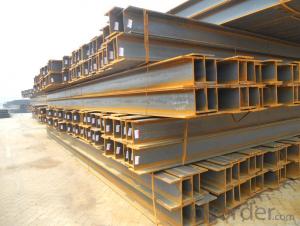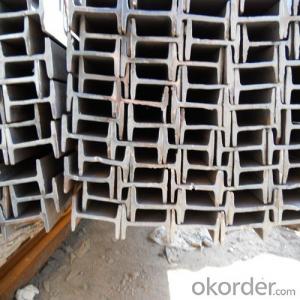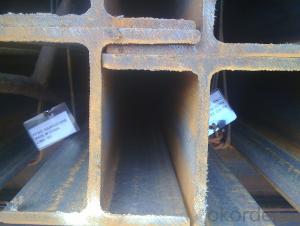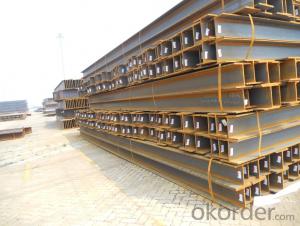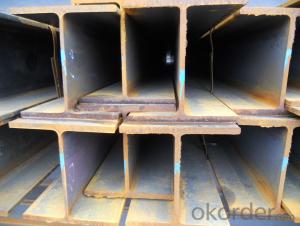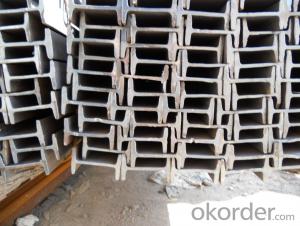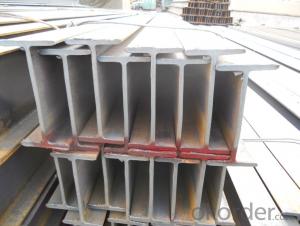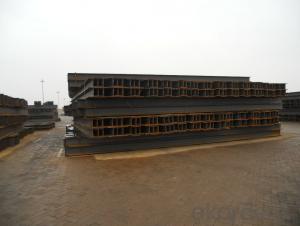Hot Rolled Steel H-Beam for Machinery Support Structure
- Loading Port:
- Tianjin
- Payment Terms:
- TT OR LC
- Min Order Qty:
- 2000 m.t.
- Supply Capability:
- 150000 m.t./month
OKorder Service Pledge
OKorder Financial Service
You Might Also Like
Specification
Product Description:
OKorder is offering Hot Rolled Steel H-Beam for Machinery Support Structure at great prices with worldwide shipping. Our supplier is a world-class manufacturer of steel, with our products utilized the world over. OKorder annually supplies products to European, North American and Asian markets. We provide quotations within 24 hours of receiving an inquiry and guarantee competitive prices.
Product Applications:
Hot Rolled Steel H-Beam for are widely used in the construction of buildings and bridges, and the manufacturing, petrochemical, and transportation industries.
Product Advantages:
OKorder's Hot Rolled Steel H-Beam for Prefabrication structure are durable, strong, and resist corrosion.
Main Product Features:
· Premium quality
· Prompt delivery & seaworthy packing (30 days after receiving deposit)
· Can be recycled and reused
· Mill test certification
· Professional Service
· Competitive pricing
Product Specifications:
Specifications of Hot Rolled Steel H-Beam for Prefabrication structure
1. Standard: Q235B2.
2. Grade: Q235, SS400 or Equivalent
3. Length:10m, 12m as following table
4. Invoicing on theoretical weight or actual weight as customer request
5.Payment: TT
6. Sizes:
SIZE(mm) | DIMENSION(kg/m) |
150*75 | 14 |
150*150 | 31.1 |
148*100 | 20.7 |
198*99 | 17.8 |
200*100 | 20.9 |
Usage & Applications of Hot Rolled Steel H-Beam for Machinery Support Structure
Commercial building structure ;Pre-engineered buildings; Machinery support structure; Prefabricated structure; Medium scale bridges; Ship-building structure. etc.
Packaging & Delivery of Hot Rolled Steel H-Beam for Machinery Support Structure
1. Packing: it is nude packed in bundles by steel wire rod
2. Bundle weight: not more than 3.5MT for bulk vessel; less than 3 MT for container load
3. Marks:
Color marking: There will be color marking on both end of the bundle for the cargo delivered by bulk vessel. That makes it easily to distinguish at the destination port.
Tag mark: there will be tag mark tied up on the bundles. The information usually including supplier logo and name, product name, made in China, shipping marks and other information request by the customer.
If loading by container the marking is not needed, but we will prepare it as customer request.
4. Transportation: the goods are delivered by truck from mill to loading port, the maximum quantity can be loaded is around 40MTs by each truck. If the order quantity cannot reach the full truck loaded, the transportation cost per ton will be little higher than full load.
5. Delivered by bulk vessel
Production flow of Hot Rolled Steel H-Beam for Prefabrication structure
Material prepare (billet) —heat up—rough rolling—precision rolling—cooling—packing—storage and transportation
FAQ:
Q1: Why buy Materials & Equipment from OKorder.com?
A1: All products offered byOKorder.com are carefully selected from China's most reliable manufacturing enterprises. Through its ISO certifications, OKorder.com adheres to the highest standards and a commitment to supply chain safety and customer satisfaction.
Q2: How do we guarantee the quality of our products?
A2: We have established an advanced quality management system which conducts strict quality tests at every step, from raw materials to the final product. At the same time, we provide extensive follow-up service assurances as required.
Images:
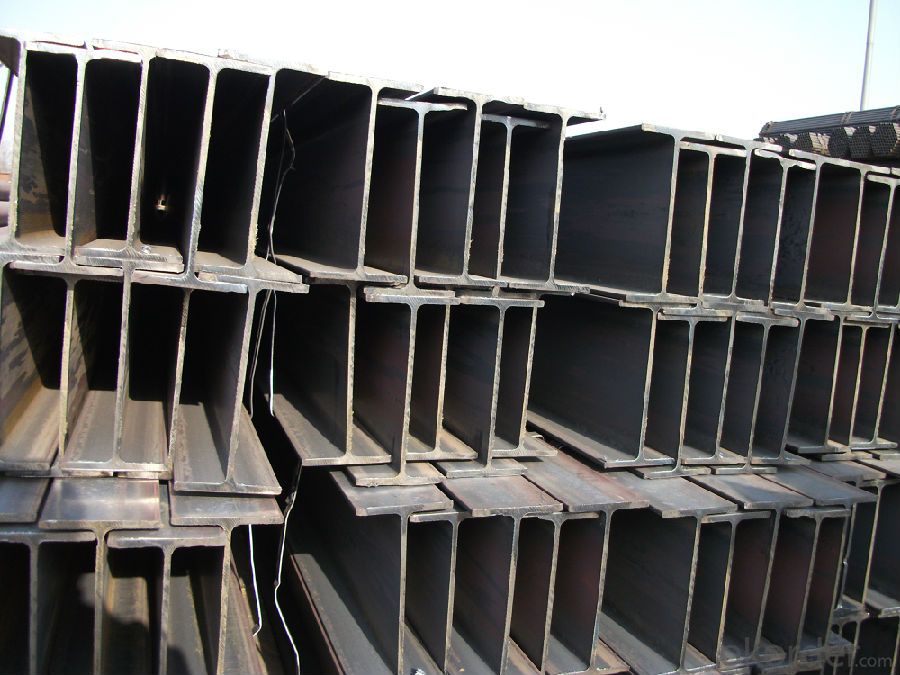
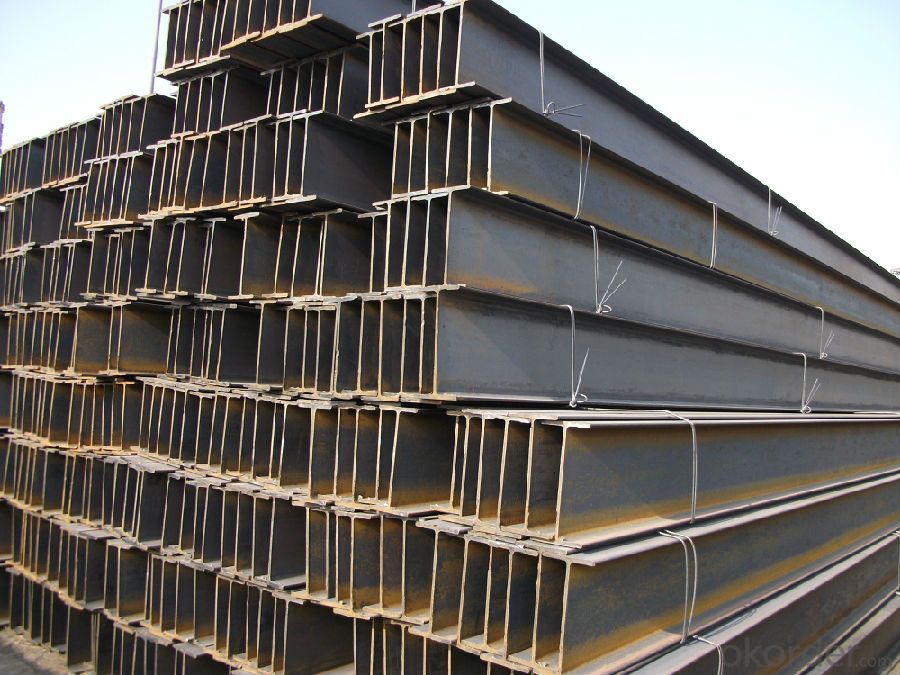
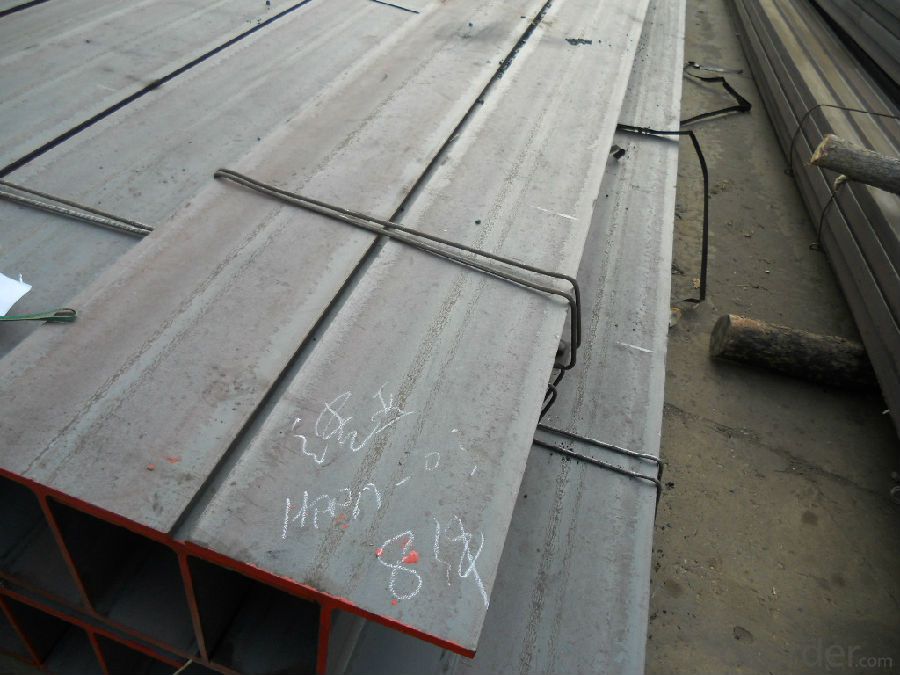
- Q: What are the applications of steel H-beams in the automotive industry?
- Steel H-beams have various applications in the automotive industry. They are commonly used in the construction of vehicle frames and chassis due to their high strength, stiffness, and durability. H-beams provide structural support and help distribute the weight and forces evenly, enhancing the overall stability and safety of the vehicle. Additionally, their lightweight nature allows for improved fuel efficiency and reduced emissions. These beams are also utilized in the manufacturing of heavy-duty trucks, buses, and off-road vehicles where the demand for load-bearing capacity is high. Overall, steel H-beams play a crucial role in enhancing the structural integrity and performance of vehicles in the automotive industry.
- Q: How are steel H-beams used in building bridges?
- Steel H-beams are commonly used in building bridges due to their strength and load-bearing capabilities. These beams provide structural support and ensure the stability of the bridge by distributing the weight of the structure evenly. They are typically used as horizontal beams to create the bridge's primary framework, supporting the deck and facilitating the passage of vehicles and pedestrians across the span.
- Q: Can steel H-beams be used for warehouse structures?
- Yes, steel H-beams can be used for warehouse structures. Steel H-beams are commonly used in construction due to their high strength and durability. They provide excellent support and stability, making them suitable for large structures like warehouses. H-beams are designed to distribute weight evenly, allowing for efficient load-bearing capacity. Additionally, steel is a versatile material that is resistant to fire, pests, and natural disasters, making it an ideal choice for warehouse construction.
- Q: Can steel H-beams be used in the construction of agricultural buildings?
- Yes, steel H-beams can be used in the construction of agricultural buildings. Steel H-beams are commonly used in construction due to their strength and durability. They provide structural support and can withstand heavy loads, making them suitable for agricultural buildings such as barns, storage facilities, or livestock shelters. Steel H-beams are also resistant to pests, rot, and fire, making them a practical choice for agricultural applications.
- Q: How do steel H-beams perform in seismic zones?
- Steel H-beams are widely used in construction, including in seismic zones, due to their excellent performance and strength. In seismic zones, where earthquake activity is more prevalent, it is crucial to use materials that can withstand the forces generated by seismic events. Steel H-beams are specifically designed to handle these forces. Their shape, with a vertical web and horizontal flanges, provides excellent resistance to bending and torsion, making them highly effective in seismic zones. The vertical web acts as a support, distributing the load evenly across the beam, while the horizontal flanges resist bending and provide stability. Additionally, steel, as a material, has excellent ductility, which is its ability to deform without breaking. When subjected to seismic forces, steel H-beams can absorb and dissipate energy through their ductility, reducing the risk of sudden failure. This property is crucial in seismic zones, as it allows the structure to undergo some deformation while maintaining its overall integrity. Moreover, steel H-beams are often used in combination with other seismic-resistant techniques, such as moment-resisting frames or base isolation systems, to further enhance their performance. These systems work together to minimize the impact of seismic forces on the structure, ensuring the safety of the building and its occupants. In conclusion, steel H-beams perform exceptionally well in seismic zones. Their design, material properties, and compatibility with other seismic-resistant techniques make them a reliable choice for construction in areas prone to earthquakes.
- Q: What are the common challenges faced during the installation of steel H-beams?
- During the installation of steel H-beams, there are several common challenges that may be encountered. These challenges include: 1. Weight and size: Steel H-beams are usually large and heavy, making them difficult to handle and maneuver during installation. The weight and size of these beams can pose challenges in terms of transportation and positioning on the construction site. 2. Alignment: Achieving proper alignment of H-beams is crucial for structural integrity. It can be challenging to ensure that the beams are perfectly aligned vertically and horizontally, especially when dealing with multiple beams or long spans. 3. Connection methods: H-beams need to be securely connected to other structural elements, such as columns or foundations. Selecting the appropriate connection method and ensuring its proper execution can be a challenge, as it requires specialized knowledge and expertise. 4. Crane and equipment limitations: The installation of steel H-beams often requires the use of cranes and other heavy equipment. However, these equipment have their limitations in terms of lifting capacity, reach, and access to the construction site. Overcoming these limitations can be a challenge, especially in tight or congested areas. 5. Safety considerations: The installation of steel H-beams involves working at height and handling heavy materials. This raises safety concerns for the workers involved. Ensuring proper safety measures, such as fall protection, proper lifting techniques, and adequate training, is critical to mitigate these risks. 6. Site conditions: The condition of the construction site can also present challenges during the installation of steel H-beams. Uneven or unstable ground, restricted access, or adverse weather conditions can all impact the installation process and require additional planning and precautions. To overcome these challenges, it is essential to have a well-coordinated plan, skilled personnel, and proper equipment. Engaging experienced professionals and ensuring effective communication among all parties involved can help address these challenges and ensure a successful installation of steel H-beams.
- Q: What are the vibration damping properties of steel H-beams?
- Steel H-beams have excellent vibration damping properties due to their high stiffness and mass. The structural design of H-beams allows them to effectively absorb and dissipate vibrations, reducing the potential for resonance and minimizing vibrations transmitted to other components or structures.
- Q: Can steel H-beams be used in theater or stage construction?
- Yes, steel H-beams can be used in theater or stage construction. Steel H-beams are strong, durable, and provide structural support, making them suitable for various construction applications, including theater and stage design. H-beams are often used to create the framework for stages, platforms, and rigging systems, providing stability and support for the various components of a stage or theater set. Additionally, steel H-beams can be easily customized and adapted to fit the specific needs and dimensions of a theater or stage design, making them a versatile choice for construction in the entertainment industry.
- Q: Are steel H-beams suitable for solar panel mounting structures?
- Yes, steel H-beams are suitable for solar panel mounting structures. They offer excellent strength and durability, making them an ideal choice for supporting the weight of solar panels. Additionally, steel H-beams can withstand various weather conditions, providing stability and longevity to the solar panel installation.
- Q: How do steel H-beams contribute to green roof design?
- The role of Steel H-beams in green roof design cannot be overstated. They are essential for providing structural support and facilitating the integration of different components. Essentially, they act as the backbone of the green roof system, ensuring its stability and durability. One of the primary advantages of using steel H-beams is their strength and ability to bear heavy loads. Green roofs, particularly those with extensive vegetation and additional features like water collection systems or rooftop gardens, can be quite weighty. Steel H-beams have the capacity to withstand this weight and distribute it evenly, thus preventing any damage or collapse. Moreover, steel H-beams offer flexibility in terms of design. They can be customized to fit the specific dimensions and layout of the green roof, allowing architects and engineers to create unique and innovative structures. This versatility is crucial for accommodating various green roof designs, whether it's a small residential building or a large commercial complex. In addition to providing structural support, steel H-beams also contribute to the sustainability of green roofs due to their recyclability. Steel is one of the most recycled materials worldwide, making it an environmentally friendly choice. By using steel H-beams in green roof construction, we can reduce the demand for new steel production, conserve resources, and minimize the carbon footprint associated with manufacturing processes. Furthermore, steel H-beams are known for their durability and long lifespan. They can endure harsh weather conditions, extreme temperatures, and UV rays without significant degradation. This durability ensures that the green roof structure will last for an extended period, reducing the need for frequent repairs or replacements. Ultimately, by reducing maintenance requirements, steel H-beams contribute to the overall sustainability of the green roof system. In conclusion, steel H-beams are indispensable in green roof design as they provide the necessary strength and stability, allow for flexible design options, and contribute to sustainability through recyclability and durability. These beams ensure the longevity of green roofs, enabling the creation of sustainable and environmentally friendly urban spaces.
Send your message to us
Hot Rolled Steel H-Beam for Machinery Support Structure
- Loading Port:
- Tianjin
- Payment Terms:
- TT OR LC
- Min Order Qty:
- 2000 m.t.
- Supply Capability:
- 150000 m.t./month
OKorder Service Pledge
OKorder Financial Service
Similar products
Hot products
Hot Searches
Related keywords
